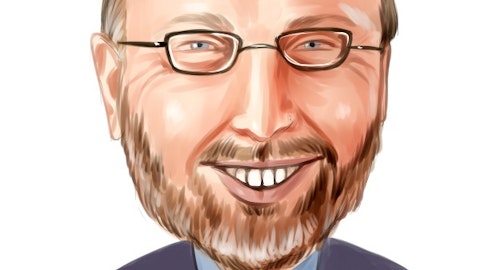Chris Caso: That’s helpful. As a follow up to that, if you could speak to the CSG and HPA businesses? And could you give us perhaps an update on what you think are longer-term growth rates for those businesses. There’s a lot of different moving parts in there, and I know through this correction, perhaps some of the expectations may have changed in that. What’s your outlook for those business as we look over the next two years or so?
Grant Brown: This is Grant, I’ll take that one too. I would think of Qorvo’s having a portfolio of diversified businesses that contribute to the revenue line. No change to our long-term growth metrics that we’ve commented on in the past. But if you decompose the business, about two-thirds of it is ACG, and this is primarily the smartphones and other cellular devices, including tablets and wearables, that we’ve largely commented on already. The other third of our revenues composed of our HPA and CSG businesses and HPA over half of that business is now defense and Aerospace and then CSG over half of that business is WiFi currently. It hasn’t always been the case and HPA base station used to be significantly larger. Those have better than corporate gross margins typically, and so that’s an area where we still have a lot of opportunity, but it’s underrepresented in HPA at the time.
Between HPA and CSG, there’s smaller portfolio businesses that range from $25 million to $75 million annually or so, and they address market opportunities in a billion. So there’s a lot of room to grow there, substantiating our comments on the strong double-digit growth rates. Our largest investments are aimed at very large customer programs, as I pointed out, in ACG for fiscal 2025 and beyond. We’re looking to scale our defense and power franchises within HPA, and we’re building our UWB and Matter business and CSG, and all combined, this collection of businesses brings the diversification and some financial resiliency, since they’re rarely, if ever, all in phase. It’s also interesting to note that in each of our operating segments, the largest businesses all benefit from our shared internal manufacturing capabilities.
Our more nascent businesses rely on external capital, and over time, we expect to grow the less capital intensive simply because of the relative growth rates in those smaller businesses.
Operator: Thank you. The next question is from Thomas O’Malley with Barclays. Please go ahead.
Thomas O’Malley: Hey, good evening guys. Thanks for taking my question. I wanted to ask kind of a broader 30,000 foot view question on Huawei’s entry into the Android market. Can you just talk about what your internal estimates are for Huawei smartphone penetration in calendar year 2024? And just how that impacts your outlook for Android, particularly as you get into the back half of the calendar year in 2024.
Robert Bruggeworth: Dave, we also add revenue, what we currently do.
Dave Fullwood: Yes, revenue is very low, near zero or at zero at this point with Huawei. But that’s a good question. I think the performance of the phones that are out there, the newer ones, I think is pretty widely known. People have done performance evaluations and there’s definitely some performance challenges on those phones. So we don’t think that they could export them to other markets. They probably have a very difficult time getting carrier approval. So we think they’re limited to China. And so, if you look at their performance to date, since the May 60 ramp, we think they did about $30 million in calendar year 2023. If you take the last four months of data and you start to project that forward, you can see an incremental 10 million to 20 million units added in CY 2024. So that’s kind of how we’re sizing it right now, and that’s all built into our models.
Grant Brown: Yes, there was probably some pent up demand from Huawei users, so we’ll have to see how that plays out and how sustainable that is. But in any case, any of those numbers you use, it’s really not that significant when you think about a 1.2 billion unit smartphone market. So it’s not that meaningful to us on a grand scale of things. And when we think about our China customers, the ones I mentioned earlier, they have pretty meaningful market shares also outside of China. And that’s where a lot of the growth is coming from that Bob talked about as the market converts to 5G because most of China has already moved to 5G. So for us, we look at that as a great opportunity to work with those customers to continue to grow and that 5G comes into our market, because we’re really not present today in the 4G portion of the market.



